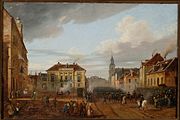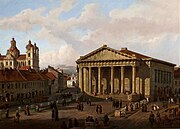Marcin Zaleski

Marcin Zaleski (* 1796 in Cracow , † September 16, 1877 in Warsaw ) was a Polish painter, university professor and representative of classicism. He was one of the most important Polish vedute painters of the 19th century.
Life
Zaleski was born in Krakow. He was self-taught . He taught himself to paint by copying paintings. As an assistant in theater decoration, he learned perspective drawing. In 1828 some of his pictures were exhibited; he won an award and a scholarship. He deepened his skills on trips to Germany, France and Italy. The painter often visited Vilna . From 1830 he lived in Warsaw. In 1846 he was appointed professor at the chair for perspective signs at the Academy of Fine Arts .
Like Wincenty Kasprzycki, he painted cityscapes in the tradition of Bernardo Bellotto , known as Canaletto. Preferred subjects were Warsaw, Vilnius (Wilna), Kaunas , Krakow, Poznan and Czestochowa . In addition, he created interior views (e.g. of churches), portraits and - especially in connection with the November Uprising in Warsaw, which he had witnessed - historical works; nevertheless, the focus is on architecture here too. Due to the precision of the buildings shown, many of his pictures were used as models for the reconstruction of the destroyed Warsaw after the Second World War .
Zaleski was buried in the Powązki Cemetery in Warsaw (grave no. 158.VI). Works by him are outside Poland in the Adam Mickiewicz Museum in Istanbul and in the Palace Museum in Homel, Belarus .
gallery
literature
- Adolf Seubert : The artists of all times and peoples. Or life and works of the most famous builders, sculptors, painters, copper engravers, form cutters, lithographers etc. In: The artists of all times and peoples: or life and works of the most famous builders, sculptors, painters, engravers, shape cutters, lithographers etc. from the earliest Art eras up to the present. 4th volume, published by Ebner & Seubert, Stuttgart 1870, p. 466 .
Individual evidence
- ↑ according to Catalogs of the Upper Austrian regional museums. Volume 1: Lothar Schultes (Red.): Longing for nature: landscapes of Europe. State museums, Linz 2009, ISBN 978-3-85474-206-7 .
- ^ A b Adolf Seubert : The artists of all times and peoples. Or life and works of the most famous builders, sculptors, painters, copper engravers, form cutters, lithographers etc. In: The artists of all times and peoples: or life and works of the most famous builders, sculptors, painters, engravers, shape cutters, lithographers etc. from the earliest Art eras up to the present. 4th volume, published by Ebner & Seubert, Stuttgart 1870, p. 466.
- ^ Tadeusz Dobrzeniecki, Art in Poland from Gothic to Today , exhibition at the Kunsthaus Zürich from June 26 to September 8, 1974, Kunsthaus Zürich, Zürich 1974.
- ^ Stanley S. Sokol, Sharon F. Mrotek Kissane, Alfred L. Abramowicz: The Polish Biographical Dictionary. Profiles of nearly 900 Poles who have made lasting contributions to world civilization. Bolchazy-Carducci Publishers, Wauconda 1992, ISBN 0-86516-245-X , p. 450.
- ^ Janusz Walek: A History of Poland in Painting. Interpress, 1988, ISBN 83-223-2115-5 , p. 110.
- ↑ Entry in the Polish personal database , see under web links
- ↑ Wojciech Chmurzyński: Adam Mickiewicz Museum in Stamboul .
Web links
- Works by Zaleski at Pinakoteka.pl
- Polish personal database
| personal data | |
|---|---|
| SURNAME | Zaleski, Marcin |
| BRIEF DESCRIPTION | Polish painter and university professor |
| DATE OF BIRTH | 1796 |
| PLACE OF BIRTH | Krakow |
| DATE OF DEATH | September 16, 1877 |
| Place of death | Warsaw |


